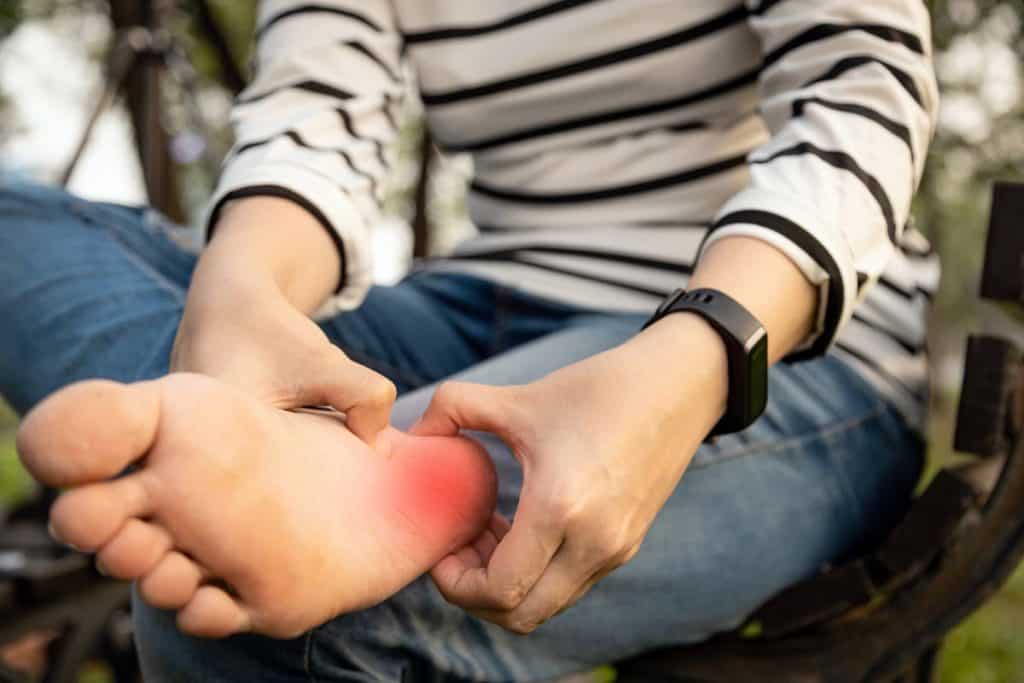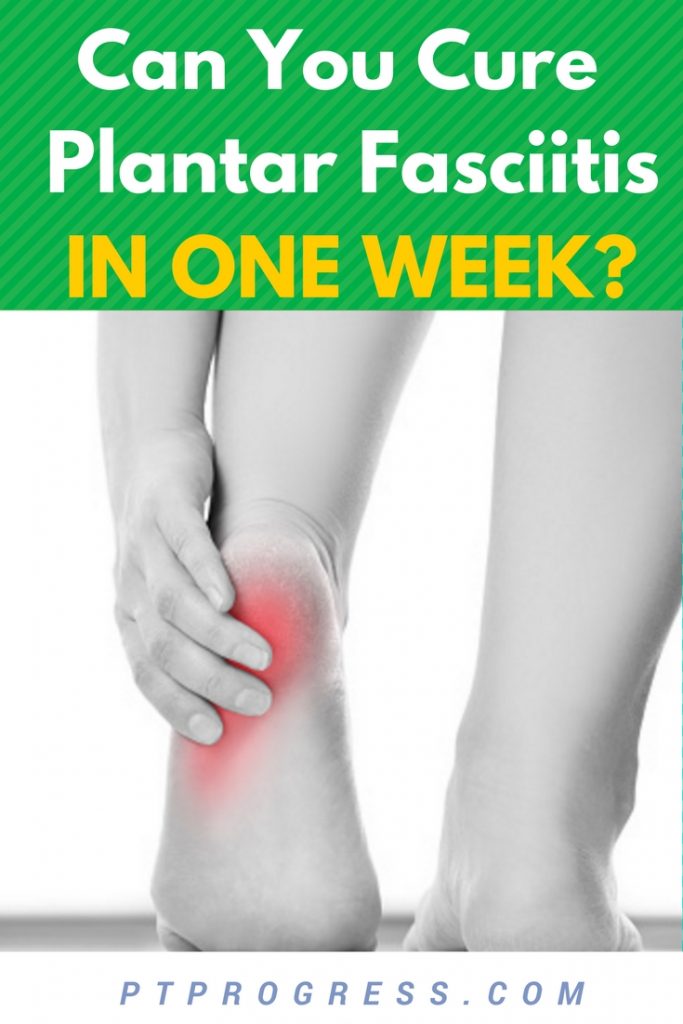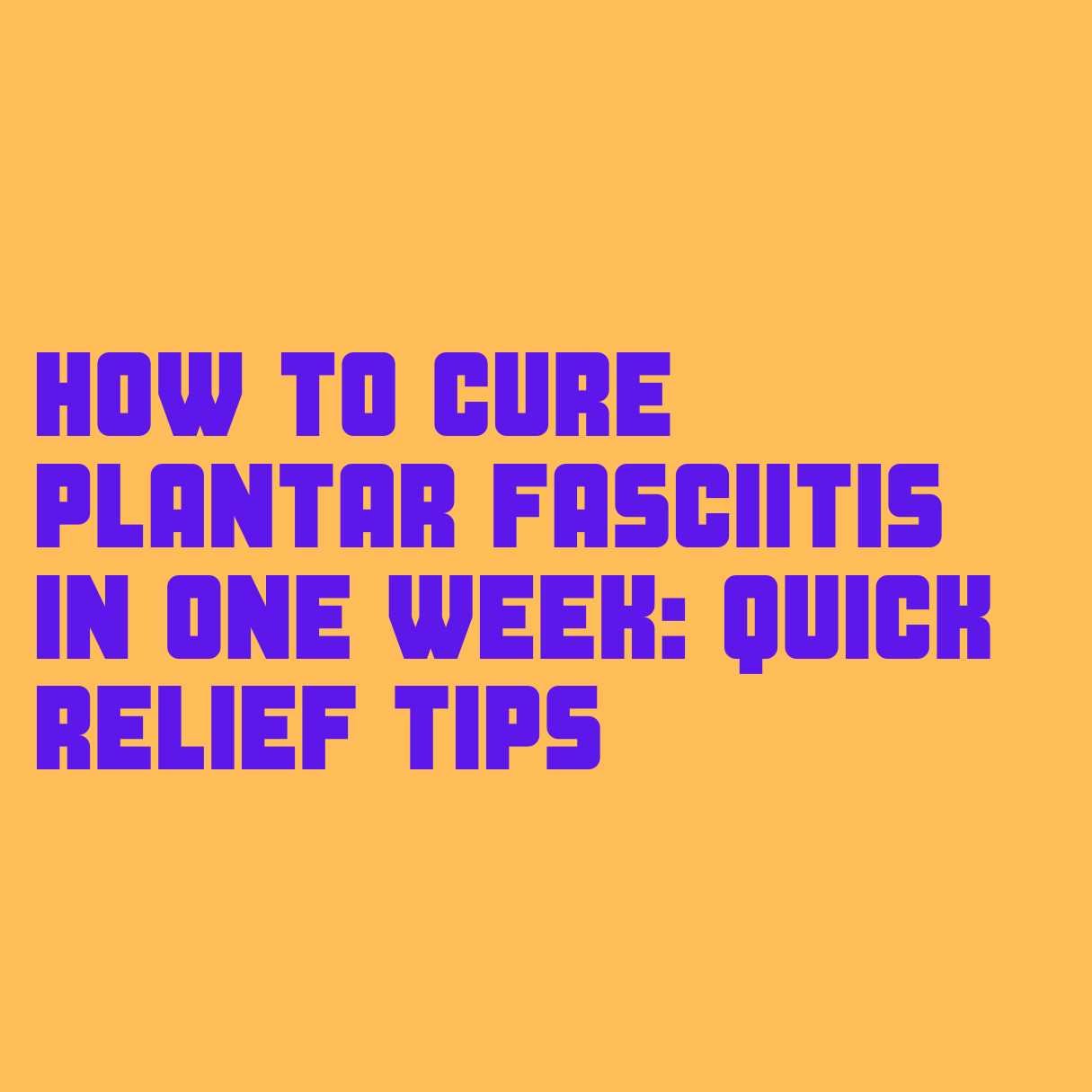How to Cure Plantar Fasciitis in One Week: Curing plantar fasciitis in one week requires consistent stretching and ice treatment. Pain relief may also involve anti-inflammatory medications and rest.
Plantar fasciitis can put a damper on daily activities due to its painful symptoms. The condition, stemming from strain and inflammation of the plantar fascia, affects the heel and the underside of the foot. Quick relief is often a priority for sufferers seeking to resume their routine without discomfort.
A diligent approach combining rest, ice, compression, and elevation—the R. I. C. E. Method—can accelerate recovery. Proper footwear with adequate support is key to both healing and prevention. Gentle stretches that target the Achilles tendon and the plantar fascia can provide significant reprieve. Moreover, over-the-counter anti-inflammatory drugs, like ibuprofen, can help manage the pain and inflammation. Although a one-week cure may be challenging, these measures can greatly reduce symptoms and pave the way to recovery.


Credit: www.relainstitute.com
The Agony Of Plantar Fasciitis
You step out of bed and a sharp pain strikes your heel. Walking feels like stepping on pins. Welcome to the world of plantar fasciitis. It’s a condition causing heel pain so intense; it can cripple your daily routine. This pain stems from the inflammation of the plantar fascia, the thick band of tissue along the bottom of your foot.
Symptoms And Quick Facts
Plantar fasciitis symptoms include:
- Sharp heel pain, especially with your first morning steps
- A feeling of heel tightness or tenderness
- Pain that decreases with movement but returns after rest
| Affected Group | Frequency |
|---|---|
| Runners | High |
| People Overweight | Common |
| Those on Their Feet a Lot | Often |
Why Speed Is Key
Quick action reduces long-term damage. A delay may worsen the condition. Healing within a week means addressing symptoms fast. This demands a mix of rest, ice, stretches, and perhaps medical advice. Act promptly for the best chance to beat plantar fasciitis quickly.


Credit: thereadystate.com
First Aid For Your Feet
If you’re dealing with plantar fasciitis, you know the pain is no small matter. Your feet need first aid to help you get back on track quickly. The techniques below provide quick relief and can be your first steps to a faster recovery within one week.
The Icing Game: A Cool Relief
Cold therapy numbs pain and reduces inflammation. Try these simple steps:
- Freeze a water bottle.
- Roll it under your foot for 5-10 minutes.
- Repeat 3-4 times a day.
Remember to wrap the ice or frozen bottle in a thin cloth to protect your skin.
Compression: Snug Support
Compression helps to support the arch and reduce swelling. Follow these tips:
- Wear a foot sleeve or compression sock during the day.
- Ensure a snug fit, but not too tight to cut off circulation.
- Choose breathable fabrics.
Combine these first aid tips with rest and proper foot care for a speedy recovery.
Stretches And Exercises You Can’t Skip
Struggling with plantar fasciitis can be discouraging, but don’t lose hope. One week can make a difference if you commit to a routine. The right stretches and exercises can ease pain. Work them into your daily schedule. Remember to listen to your body and adjust the intensity when needed.
Towel Stretch: A Gentle Start
Begin your morning with the towel stretch. This easy move loosens up the plantar fascia. It prepares your feet for the day ahead. Here’s a simple way to do it:
- Sit with your legs straight.
- Loop a towel around your affected foot.
- Pull gently toward you.
- Hold for 15-30 seconds.
- Repeat 3 times.
Do this stretch first thing in the morning. It’s gentle on the feet.
Calf Raises: Building Strength
Calf raises promote healing and strength. These are critical for recovery. Follow these steps:
- Stand with feet hip-width apart.
- Raise your heels slowly.
- Lower them with control.
- Aim for 10-15 reps.
- Complete 2-3 sets.
Perform calf raises on a flat surface. For extra challenge, do them on a step. They target muscles connected to your plantar fascia.
Home Remedies And Lifestyle Adjustments
Home Remedies and Lifestyle Adjustments can play a crucial role in overcoming plantar fasciitis swiftly. Adopting simple yet effective strategies can aid in alleviating heel pain within a week’s time. Explore how right shoes and diet transform discomfort into relief.
Footwear Fixes: Choosing The Right Shoes
The journey to healing begins at your feet. Selecting appropriate footwear is essential for immediate comfort:
- Avoid high heels – they can strain your fascia.
- Look for shoes with good arch support and cushioning.
- Orthotic inserts can provide extra support.
- Replace worn-out shoes – they lack support and cushioning.
- Consider special night splints to stretch your feet while sleeping.
Anti-inflammatory Diet: Food For Your Feet
What you eat can influence inflammation in your body. Embrace an anti-inflammatory diet:
| Include | Avoid |
|---|---|
|
|
Stay hydrated; drink lots of water. Limit caffeine and alcohol as they can contribute to inflammation.
When To Seek Professional Help
Plantar fasciitis can cause stubborn heel pain. It makes everyday walking tough.
<p>Try home remedies first. Ice your feet. Change your shoes. Rest. Stretch.Sometimes, pain stays. It can last for months. Pain changes your walk. Then, it’s time
to get help. Doctors and therapists can guide you. They use special tools and knowledge
to make you better faster.
Physical Therapy: Guided Recovery
Physical therapy (PT) is a powerful way to heal. It helps with pain and movement.
A good PT plan can speed up healing. It might even fix your pain in one week.
PT includes:
- Stretches: These keep your feet limber.
- Exercises: They strengthen foot muscles.
- Massage: This reduces tightness in the foot.
Orthotic Solutions: Customized Comfort
Orthotics are special shoe inserts. They support your feet.
These devices align your walk. They ease the stress on your feet.
Orthotics come in two types:
- Over-the-counter: These are ready to buy and use.
- Custom: Doctors make these just for your feet.
Preventative Measures For The Future
After addressing plantar fasciitis, safeguarding your feet prevents future flare-ups. Proper care and attentiveness are vital and Let’s dive into effective strategies.
Routine Foot Care: A Must
Daily foot care is essential in avoiding plantar fasciitis. Here’s a simple routine:
- Hydrate your skin with lotion to prevent cracking.
- Cool down exercises after heavy activity ease tension.
- Invest in orthotic inserts that provide arch support.
- Gentle stretches before bed can maintain flexibility.
Think of your feet as a foundation that needs consistent maintenance.
Awareness Of Limits: Listening To Your Body
Understanding your body’s signals is crucial in preventing injury recurrence.
| Signs | Action |
|---|---|
| Foot Soreness | Rest and ice the area. |
| Heel Discomfort | Consider low-impact activities. |
| Arch Pain | Use supportive footwear. |
Never push through sharp foot pains. Rest and reassess your activities.


Credit: www.ptprogress.com
Frequently Asked Questions On How To Cure Plantar Fasciitis In One Week
What Is The Fastest Cure For Plantar Fasciitis?
The quickest remedy for plantar fasciitis typically involves rest, ice, compression, and elevation, along with stretching exercises and anti-inflammatory medications. Consult a medical professional for personalized treatment options.
Is It Ok To Walk If You Have Plantar Fasciitis?
Walking with plantar fasciitis requires caution. Choose supportive footwear and avoid hard surfaces. Short, frequent walks can help, but rest if pain increases. Gradually increase your distance as the pain diminishes. Consider low-impact exercises as alternatives during recovery.
Can Plantar Fasciitis Go Away In 2 Days?
Plantar fasciitis typically requires weeks to months to heal fully. Complete recovery within 2 days is unlikely. Rest, ice, and proper footwear can help manage symptoms.
Should You Massage Plantar Fasciitis?
Massaging plantar fasciitis can reduce pain and aid in recovery. Apply gentle pressure and stretch the foot arch, focusing on tender areas. Gradual and consistent massage helps, but avoid excessive force which may worsen symptoms. Always consult a healthcare professional for personalized advice.
Conclusion
Conquering plantar fasciitis swiftly hinges on your commitment to following the specified tips. Key to recovery is consistency with daily stretches, proper footwear, and icing routines. Rapid relief can be achieved—take the first step towards pain-free walking now. Remember, each foot’s journey to healing is as unique as its stride.
Plantar Fasciitis Embrace the process, and savor the stride ahead.

